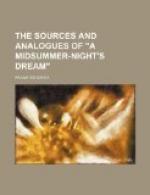* * * * *
Sec. 2. THE GROTESQUE PLOT: BOTTOM AND THE ASS’S HEAD: WITH THE INTERLUDE OF PYRAMUS AND THISBE
“But, for I am a man noght textuel,
I wol noght telle of textes never a del;
I wol go to my tale.”—Chaucer.
* * * *
II
The second portion of our study will not detain us long, as there are no literary sources for the “rude mechanicals,” and their interlude of Pyramus and Thisbe is derived from a well-known classical story. Shakespeare draws them from life, and from his own observation of Warwickshire rustics, as he drew the two Gobbos, Launce, Christopher Sly, and a host of minor characters. Doubtless he had met many of the crew of patches, perhaps beneath the roof of “Marian Hacket, the fat ale-wife of Wincot,” where we may suppose him to have made merry with “Stephen Sly, and old John Naps of Greece, and Peter Turf, and Henry Pimpernell.”
Bottom takes his name from the wooden reel or spool on which thread is wound; “bottom” simply meaning the base or foundation of the reel. The names of his comrades have no specific connection with the trades they ply; but “Starveling” is appropriate by tradition for a tailor—it takes seven tailors to make a man.
The episode of Bottom’s “translation,” or transformation into an ass, may have been suggested to Shakespeare by a passage in Reginald Scot’s Discovery of Witchcraft (1584)—a book with which he must have been acquainted, as we shall see in discussing the fairy-section of the play. Scot mentions the supposed power of witches to change men into animals, and quotes (in order to discredit) some recorded instances. Chief among these is the story[21] of an English sailor abroad, who got into the power of a witch and was transformed by her into an ass, so that when he attempted to rejoin his crew, he was beaten from the gangway with contempt. This will be found in the third chapter of Scot’s fifth book: Of a man turned into an asse, and returned againe into a man by one of Bodin’s witches: S. Augustine’s opinion thereof. “Bodin” is Jean Bodin, who wrote a book de Magorum Daemonomania (1581; a French version was published in the previous year), and mentions this story (lib. 2, cap. vi.). According to Scot, Bodin takes the story “out of M. Mal. [Malleus Maleficarum], which tale was delivered to Sprenger by a knight of the Rhodes.”
Scot mentions further the famous story of the Golden Ass of Apuleius[22]; a legend of the reappearance of one of the Popes, a hundred years after his death, with an ass’s head; and gives a charm to put an ass’s head on a man.[23]




